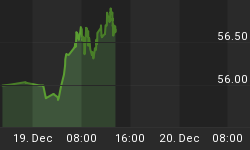The S&P 500 is right back where it started at the beginning of the year (after a very strong December rally), as this percentage performance chart indexed to the beginning of the year shows.

So, let's see how various key parts of the US equity market are doing.
Small caps have been leading the overall market up over the past year -- typical of a Bull phase, but they are becoming relatively weaker on overall market weakness, as is happening now.
(in this chart red = small caps [Russell 2000] and black = large caps [Russell 1000])

Looking at symbols you may know, this plots VTI (total US market) versus OEF (S&P 100 mega cap), SPY (S&P 500 large and mega cap), and IWM (Russell 2000 small cap). We sold our IWM and active small cap funds today and will reinvest in lower volatility large cap stocks. Valuation of small cap stocks seems too high now.

This chart shows the total US stock market (VTI) versus other developed markets (VEU), and emerging markets (EEM), as well as versus the total US bond market (BND) and the total non-US bond market (BNDX).

Bonds have been chugging along +/- of the zero line, and the US stock market has outperformed other developed and emerging markets. The emerging markets have P/E ratios in the single digits, versus above average valuations here -- but emerging markets are more volatile and more vulnerable to world events and economic changes.
Looking at the constituents of key US stock indexes in terms of their chart conditions is partially possible via this table, which shows the percent of constituents with Bullish Point & Figure Charts (you don't need to know what a P&F chart is, just that they can be rated Bullish or Bearish); and the percent of the constituents that have prices above their 200-day and 50-day moving averages (popular technical indicators).

The heat map shading shows NASDAQ as weakest, and utilities as strongest, in what is clearly a move to safety, or a move away from momentum at this time.
We may be entering the long predicted correction, but there is no current indication of a Bear move. However, it should not be ignored that we have high equity prices, low bond yields, zero income of cash deposits a bit of inflation to eat away at cash; each of which is unfavorable.















